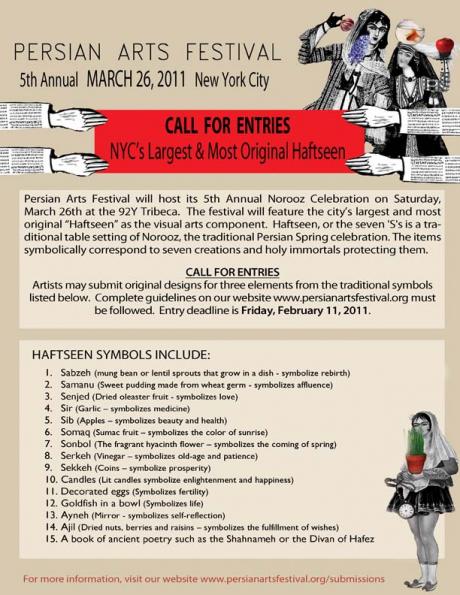به زبان فارسی
PICTORY
LATEST MUSIC
SEARCH
Call for Entries for Persian Arts Festival's Largest and Most Original Haftseen!
by monakayhan
13-Jan-2011
Persian Arts Festival will host its 5th Annual Norooz Celebration on Saturday, March 26th at the 92Y Tribeca. The festival will feature the city’s largest and most original “Haftseen” as the visual arts component. Haftseen, or the seven 'S's is a traditional table setting of Norooz, the traditional Persian Spring celebration. The items symbolically correspond to seven creations and holy immortals protecting them.
DOWNLOAD POSTER as PDF.
poster artist: Khandan Bigdeli
IMPORTANT DATES:
Entries due:
February 11, 2011
Notice of acceptance:
March 1, 2011
Festival date:
March 26, 2011
GUIDELINES
PLEASE REVIEW IMPORTANT DATES (above) and READ ALL OF THE GUIDELINES LISTED (below).
Artists may submit original designs for three elements from the traditional symbols listed below. We will be selecting several artists to participate in what will be a collection of works to create the largest Haftseen that New York City has seen yet. We want to have fun with this project and present a myriad of talent, ideas, perspectives and interpretations of the traditional Haftseen table settings used in Norooz celebrations, both public and private. If you have any questions please send them to the same email listed below. We look forward to receiving your entry.
HAFTSEEN SYMBOLS
Be creative.
Choose 3 symbols from this list:
1. Sabzeh (mung bean or lentil sprouts that grow in a dish - symbolize rebirth)
2. Samanu (Sweet pudding made from wheat germ - symbolizes affluence)
3. Senjed (Dried oleaster fruit - symbolizes love)
4. Sir (Garlic – symbolizes medicine)
5. Sib (Apples – symbolizes beauty and health)
6. Somaq (Sumac fruit – symbolizes the color of sunrise)
7. Sonbol (The fragrant hyacinth flower – symbolizes the coming of spring)
8. Serkeh (Vinegar – symbolizes old-age and patience)
9. Sekkeh (Coins – symbolize prosperity) *
10. Candles (Lit candles symbolize enlightenment and happiness) *
11. Decorated eggs (Symbolizes fertility)
12. Goldfish in a bowl (Symbolizes life)
13. Ayneh (Mirror - symbolizes self-reflection) *
14. Ajil (Dried nuts, berries and raisins – symbolizes the fulfillment of wishes)
15. A book of ancient poetry such as the Shahnameh or the Divan of Hafez.*
* these items will be returned to artist after festival upon request.
Entry Application must include the following:
1. "PAF 2011 Submission" must be in the subject line of your email
2. Full name & phone number
3. List of the 3 symbols you have chosen from the list above
4. Image(s) or sketches of the 3 symbols (accepted formats include jpg, gif, tif, bmp, epd, psd, ai, pdf)
5. Description of your entries, how they'd be included/presented on the Haftseen, any special assembly/instructions.
6. Artist Statement
7. (if available) Links to your artwork, website or portfolio
Entry deadline is Friday, February 11, 2011.
Email your entry to submissions@persianartsfestival.org
Judging and Selection of Winners -
Entries will be reviewed by a selection panel and notified by March 1, 2011.
All entries will be judged based on the following criteria:
1) representation of the spirit of Norooz and the arrival of Spring;
2) creativity;
3) originality;
4) universality and transcendence of national boundaries;
5) artistic beauty; and
6) appropriateness
Eligibility -
Open to artists of ALL AGES from around the world who submit artwork from the provided Haftseen symbols/elements. Submissions must be the creation of the artist.
Use Rights -
By submitting work to be considered for the exhibition, artists grant Persian Arts Festival the right to use their image(s) for the purpose of marketing.
THANK YOU, we look forward to receiving your entry.
Persian Arts Festival Crew
RECENT COMMENTS
IRANIANS OF THE DAY
| Person | About | Day |
|---|---|---|
| نسرین ستوده: زندانی روز | Dec 04 | |
| Saeed Malekpour: Prisoner of the day | Lawyer says death sentence suspended | Dec 03 |
| Majid Tavakoli: Prisoner of the day | Iterview with mother | Dec 02 |
| احسان نراقی: جامعه شناس و نویسنده ۱۳۰۵-۱۳۹۱ | Dec 02 | |
| Nasrin Sotoudeh: Prisoner of the day | 46 days on hunger strike | Dec 01 |
| Nasrin Sotoudeh: Graffiti | In Barcelona | Nov 30 |
| گوهر عشقی: مادر ستار بهشتی | Nov 30 | |
| Abdollah Momeni: Prisoner of the day | Activist denied leave and family visits for 1.5 years | Nov 30 |
| محمد کلالی: یکی از حمله کنندگان به سفارت ایران در برلین | Nov 29 | |
| Habibollah Golparipour: Prisoner of the day | Kurdish Activist on Death Row | Nov 28 |




Majid
by Ari Siletz on Fri Jan 14, 2011 03:47 AM PSTAri
by Majid on Fri Jan 14, 2011 02:20 AM PSTThat's what I was thinking about! :"What do they have in mind" and what do they mean by ORIGINAL?
I hope they'd define it a little more, it'll definitely help participating artists.
Majid
by Ari Siletz on Fri Jan 14, 2011 01:49 AM PSTAri
by Majid on Fri Jan 14, 2011 01:44 AM PSTBy "MOST ORIGINAL" I don't think if they consider a modern or creative entry as a candidate showpiece, although it would be a great idea if they did.
Mash Ghasem,
by Ari Siletz on Thu Jan 13, 2011 08:39 PM PSTMost "original" Haftseen?
by Mash Ghasem on Thu Jan 13, 2011 07:53 PM PSTNot to sound critical or anything like that , but, just how "original" a ritual can get?
However, the young lady holding that original Sabzeh is enticing, and those eyebrows: to die for!
Looking forward to this!
by Ari Siletz on Thu Jan 13, 2011 07:35 PM PST